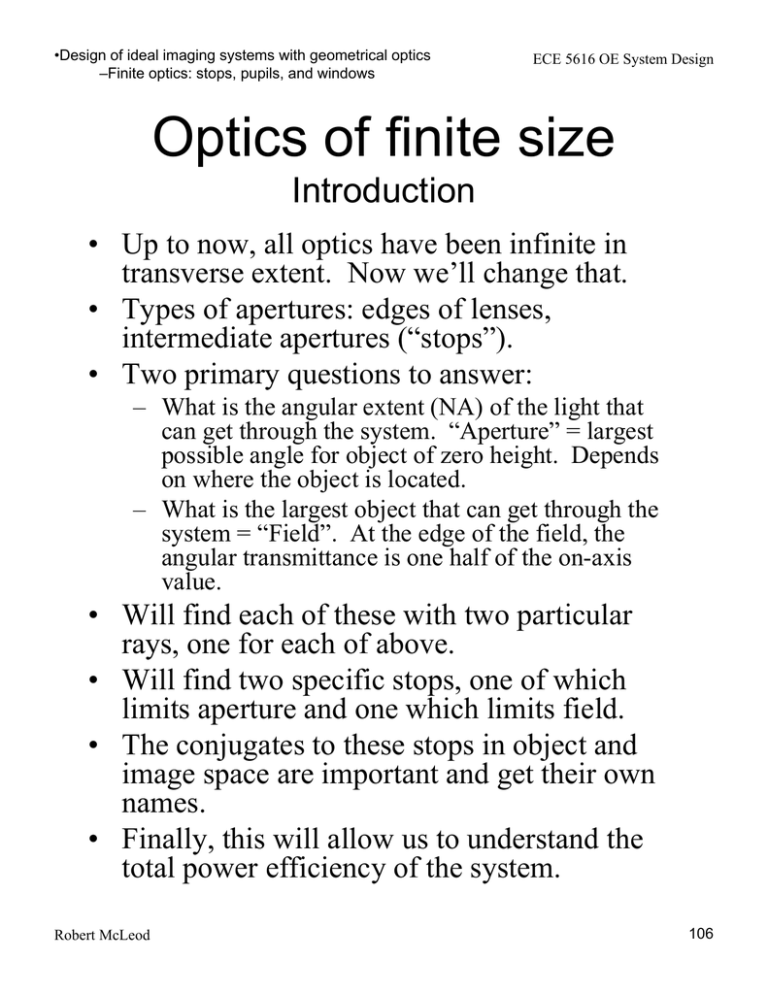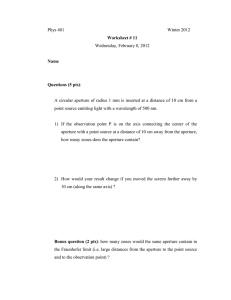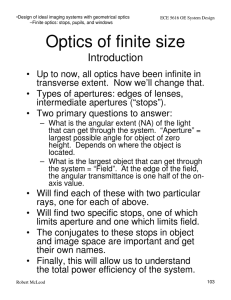Apertures and stops
advertisement

•Design of ideal imaging systems with geometrical optics –Finite optics: stops, pupils, and windows ECE 5616 OE System Design Optics of finite size Introduction • Up to now, all optics have been infinite in transverse extent. Now we’ll change that. • Types of apertures: edges of lenses, intermediate apertures (“stops”). • Two primary questions to answer: – What is the angular extent (NA) of the light that can get through the system. “Aperture” = largest possible angle for object of zero height. Depends on where the object is located. – What is the largest object that can get through the system = “Field”. At the edge of the field, the angular transmittance is one half of the on-axis value. • Will find each of these with two particular rays, one for each of above. • Will find two specific stops, one of which limits aperture and one which limits field. • The conjugates to these stops in object and image space are important and get their own names. • Finally, this will allow us to understand the total power efficiency of the system. Robert McLeod 106 •Design of ideal imaging systems with geometrical optics –Finite optics: stops, pupils, and windows ECE 5616 OE System Design The aperture stop and the paraxial marginal ray. Aperture stop Paraxial marginal ray (PMR) D A diaphragm that is not the aperture stop • Launch an axial ray, the paraxial marginal ray, from the object. • Increase the ray angle until it just hits some aperture. • This aperture is the aperture stop. • The sin of is the numerical aperture. • The aperture stop determines the system resolution, light transmission efficiency and the depth of field/focus. Robert McLeod 107 •Design of ideal imaging systems with geometrical optics –Finite optics: stops, pupils, and windows ECE 5616 OE System Design Pupils The images of the aperture stop Exit pupil Aperture stop and entrance pupil Paraxial marginal ray (PMR) D A diaphragm that is not the aperture stop The entrance (exit) pupil is the image of the aperture stop in object (image) space. • • • • Axial rays at the object (image) appear to enter (exit) the system entrance (exit) pupil. When you look into a camera lens, it is the pupil you see (the image of the stop). Both pupils and the aperture stop are conjugates. A ray launched into the exit pupil will make it through the aperture stop – this is a major reason the pupil is a useful concept. Robert McLeod O’Shea 2.4, M&M chapter 5 108 •Design of ideal imaging systems with geometrical optics –Finite optics: stops, pupils, and windows ECE 5616 OE System Design Windows Images of the field stop Aperture stop Field stop • Launch an axial ray, the chief ray, from the aperture stop. • Increase the ray angle until it just hits some aperture. • This aperture is the field stop. • The angle of the chief ray in object space is the angular field of view. • The height of the chief ray at the object is the field height. • The chief ray determines the spatial extent of the object which can be viewed. When that object is very far away, it is convenient to use an angular field of view. • When the field stop is not conjugate to the object, vignetting occurs, cutting off ~half the light at the edge of the field. Robert McLeod 109 •Design of ideal imaging systems with geometrical optics –Finite optics: stops, pupils, and windows ECE 5616 OE System Design Field stops and windows Definitions Entrance Window Aperture stop Field stop & Exit Window Chief ray M&M refer to the chief ray as the paraxial pupil ray (PPR) The entrance (exit) window is the image of the field stop in object (image) space. Robert McLeod 110 •Design of ideal imaging systems with geometrical optics –Finite optics: stops, pupils, and windows ECE 5616 OE System Design Numerical aperture The measure of angular bandwidth NA n sin D pupil 2 F 1 F# 2 NA F D pupil r0 0.6 NA Definition of numerical aperture. Note inclusion of n in this expression. Paraxial approximation Definition of F-number Paraxial approximation F# Radius of Airy disk NA is the conserved quantity in Snell’s Law because it represents the transverse periodicity of the wave: k x 2 f x 2 0 n sin 2 0 NA Therefore NA/0 equals the largest spatial frequency that can be transmitted by the system. Note that NA is a property of cones of light, not lenses. Robert McLeod 111 •Design of ideal imaging systems with geometrical optics –Finite optics: stops, pupils, and windows ECE 5616 OE System Design Effective F# Lens speed depends on its use Infinite conjugate condition 1 F# 2 NA f D D Finite conjugate condition t f 1 M D D 1 M F # Fi# f 1 M1 t F # D D 1 M1 F # o or Robert McLeod t D t’ NAi NA 1 M NAo NA 1 M1 112 •Design of ideal imaging systems with geometrical optics –Finite optics: stops, pupils, and windows ECE 5616 OE System Design Depth of focus Dependence on F# Your detection system has a finite resolution of interest (e.g. a digital pixel size) = Exit pupil Limited object DOF D z z 2 F # * 2 From geometry. F*# = Fo# or Fi# depending on which space we’re in NA* 4 F # 1.2 * Source: Wikipedia NA * 2 If = 2r0 = Airy disk diameter First eq. is “detector limited”, second is “diffraction limited” Thus as we increase the power of the system (NA increases) the depth of field decreases linearly for a fixed resolvable spot size or quadratically for the diffraction limit r0. Robert McLeod M&M 5.1.3 113 •Design of ideal imaging systems with geometrical optics –Finite optics: stops, pupils, and windows ECE 5616 OE System Design Hyperfocal distance Nominal focus Near point Far point Important for fixed-focus systems Entrance pupil D z Depth of Field Note how each focus falls within the acceptable blur The object distance which is perfectly in focus on the detector is defines the nominal system focus plane. When this plane is positioned such that the far point goes to infinity, then the system is in the “hyperfocal” condition and the nominal focus plane is called the “hyperfocal distance”. This is very handy for fixed focus cameras – you can take a portrait shot (if the person is beyond the near point) out to a landscape and not notice the defocus. Robert McLeod 114 •Design of ideal imaging systems with geometrical optics –Finite optics: stops, pupils, and windows ECE 5616 OE System Design Vignetting Losing light apertures or stops Example of vignetting Take a cross-section through the optical system at the plane of any aperture. Launch a bundle of rays off-axis and see how they get through this aperture: Ray bundle of radius y Unvignetted a y y Central ray height, y Aperture radius = a Ray bundle of radius y Central ray height, y Fully vignetted a y y Robert McLeod Aperture radius = a 115 •Design of ideal imaging systems with geometrical optics –Finite optics: stops, pupils, and windows ECE 5616 OE System Design Pupil matching Off-axis imaging & vignetting Exit pupil of telescope (image of A.S. in image space) matches entrance pupil of following instrument (eye). f1 f2 A.S. Good place for a field stop if the object is at infinity. Note that the entrance pupil in the system above will appear to be ellipsoidal for off-axis points. Thus even in this well-designed, aberration-free case, off-axis points will not be identical on axis. Vignetting: Further, we might find extreme rays at off-axis points are terminated. This loses light (bad) but also loses rays at extreme angles, which might limit aberrations (good). f1 f2 A.S. Robert McLeod 116 •Design of ideal imaging systems with geometrical optics –Finite optics: stops, pupils, and windows ECE 5616 OE System Design Telecentricity Aperture stop f1 f2 In a telecentric system either the EP or the XP is located at infinity. The system shown above is doubly telecentric since both the EP and the XP are at infinity. All doubly telecentric system are afocal. When the stop is at the front focal plane (just lens f2 above) the XP is at infinity and slight motions of the image plane will not change the image height. When the stop is at the back focal plane (just lens f1 above) the EP is at infinity and small changes in the distance to the object will not change the height at the image plane. Telecentricity is used in many metrology systems. Robert McLeod 117 •Design of ideal imaging systems with geometrical optics –Finite optics: stops, pupils, and windows ECE 5616 OE System Design Analyzing an optical system 1. Specify the system via distances, component locations, focal length, and clear apertures. 2. Run a marginal ray using a y-u trace 3. Find the aperture stop (calculate the ratio of clear aperture to ray height (smallest r/yk is aperture stop) 4. Run a chief ray trace 5. Calculate as in step 3 above to find field stop 6. Find locations of pupils and windows via thin lens equations if small # of elements or yu/matrix methods if large #. 7. Sizes of pupils can be determined by taking the slope angle of the chief ray at the aperture stop and dividing by the image and object space slope angles of that ray to get the magnification of the aperture stop in image and object space, respectively. Multiplying the aperture stop size by the magnification gives the exit and entrance pupil sizes. (Optical invariant is the basis). A full report of a optical system contains: image location and magnification, the location of stops, pupils, and windows, the effective focal length of the system, F/#, and its angular field of view. Robert McLeod 118 •Design of ideal imaging systems with geometrical optics –Example ECE 5616 OE System Design Detailed example Holographic data storage B .S . Object beam shutter S LM o b jec t referen c e SLM Imaging Lens x y R efe ren ce Tel es co pe Ho l og rap h ic Ga lvo M at eria l M i rro r Linear CCD C orrel ati o n Im a g in g Le n s CCD We’re going to design the imaging path Robert McLeod 119 •Design of ideal imaging systems with geometrical optics –Example ECE 5616 OE System Design 1 to 1 imaging Aperture in Fourier plane Lens SLM Aperture CCD Material 40 mm DSLM=10 mm p = 10 m 20 mm DLens=10 mm f = 20 mm 20 mm DAp= 2 mm DCCD=10 mm Fourier diffraction calculation for a random pixel pattern. CCD Lens SLM Robert McLeod 120 •Design of ideal imaging systems with geometrical optics –Example ECE 5616 OE System Design Finding the aperture stop Trace the paraxial marginal ray (PMR) 0 1 2 3 SLM Lens Aperture CCD yk 1 u k k 0 yk 1 u k yk 1 1 t k yk u 0 1 u k k 1 DSLM=10 mm p = 10 m DLens= 10 mm f = 20 mm DAp= 2 mm DCCD=10 mm Aperture stop Surf 0 1 1’ 2 3 y 0 .4 .4 .2 0 u’ .01 .01 -.01 -.01 -.01 .08 .08 .2 y/r PMR y 0 2 2 1 0 PMR u’ .05 .05 -.05 -.05 -.05 Robert McLeod 121 •Design of ideal imaging systems with geometrical optics –Example ECE 5616 OE System Design What does the aperture stop do? Limits the NA of the system NA* y=2 mm rAS= 1 mm NA 40 mm What is the lens effective NA? NA* D/2 5 1 f (1 M ) 20(2) 8 However we have stopped the system down to NA = 2/40=1/20 Pixel size = 10 m NApix p .5 1 10 20 The aperture stop thus: 1. Determines the system field of view 2. Controls the radiometric efficiency 3. Limits the depth of focus 4. Impacts the aberrations 5. Sets the diffraction-limited resolution Robert McLeod 122 •Design of ideal imaging systems with geometrical optics –Example ECE 5616 OE System Design Find the entrance pupil (image of aperture stop in object space) Aperture stop and exit pupil Entrance pupil 1 1 1 t0 t1 f 1 1 1 20 t1 20 t1 What’s that mean? If the entrance pupil is at infinity, then every point on the object radiates into the same cone: Robert McLeod 123 •Design of ideal imaging systems with geometrical optics –Example ECE 5616 OE System Design Find the field stop Trace the chief ray (PPR) SLM Lens Aperture CCD yk 1 u k k 0 yk 1 u k yk 1 1 t k yk u 0 1 u k k 1 DSLM=10 mm p = 10 mm DLens= 10 mm f = 20 mm DAp= 2 mm DCCD=10 mm Field stop Surf y 0 .2 1 .2 1’ .2 2 0 3 -.2 u’ 0 0 -.01 -.01 -.01 .04 .04 0 5 5 0 y/r PPR y 5 Robert McLeod Entrance -5 and exit windows at field stop (since it is lens). 124 •Design of ideal imaging systems with geometrical optics –Example ECE 5616 OE System Design Required lens diameter And why windows should be at images Object vignetted at edges NApix Note that the extreme marginal ray makes the same angle with the chief ray (PPR) as the paraxial marginal ray (PMR) makes with the axis. Thus to fit the extreme marginal ray through an aperture, we require: D 2 y y 22 5 12 • Now the camera is the field stop and the entrance window is the SLM. • The optical system now captures the same light from each SLM pixel and it can be adjusted for all pixels via the aperture stop. • Independently, we can adjust the field size. Robert McLeod M&M 5.1.8 125 •Design of ideal imaging systems with geometrical optics –Summary ECE 5616 OE System Design Thicken the lenses Gaussian design Lens P P’ SLM Aperture 40 mm DSLM=10 mm p = 10 m Robert McLeod 5 mm 20 mm DLens=12 mm F = 20 mm CCD 20 mm DAp= 2 mm DCCD=10 mm 126 •Design of ideal imaging systems with geometrical optics –Finite optics: stops, pupils, and windows ECE 5616 OE System Design Optical invariant aka Lagrange or Helmholtz invariant Write the paraxial refraction equations for the marginal ray (PMR) and chief or pupil ray (PPR): nu nu y nu nu y With a bit of algebra: nu y u y nu y u y So H nu y u y is conserved. At the object (or image) of limited field diameter L: y 0, y edge of field, u maximum ray angle L L H nu y NA .6 N spots 2 r0 2 2 Thus we have found the information capacity of the optical system, aka the space-bandwidth product: Where “spots” here are 2 separated by their N spots H diameter, 2r0 Robert McLeod 127 •Design of ideal imaging systems with geometrical optics –Finite optics: stops, pupils, and windows ECE 5616 OE System Design Typical number of resolvable spots A survey of >3000 optical designs N spots Image field diameter Spot diameter So, for a well-optimized system up to ~ 4 elements, we have 1200 spots/element, monochromatic systems with all-spherical elements 1600 spots/element, monochromatic systems with some aspheric elements 1100 spots/element, polychromatic systems with all-spherical elements 1100 spots/element, polychromatic systems with some aspheric elements Robert McLeod Design Efficiency of 3188 Optical Designs, Proc. of SPIE Vol. 7060 70600S-1 128 •Design of ideal imaging systems with geometrical optics –Summary ECE 5616 OE System Design Optical invariant for the holographic storage example N spots 2H 0 2 y0 NA0 Definition of optical invariant 0 DSLM 0 0 p Stopped-down NA DSLM p N pix So we have correctly designed this system to transmit the proper number of resolvable spots. Robert McLeod 129 •Design of ideal imaging systems with geometrical optics –Summary ECE 5616 OE System Design Counting resolvable waves in the pupil Remove quadratic phase of converging wavefront. Remainder is rect with linear phase (=tilt) whose FT is a shifted sinc in the image plane. d DXP r0 X.P. Wavefronts in AS xXP rXP xXP E -rXP K-space (what is in AS?) fxp fXP fz E Fourier Transform Spectrum in AS 1 / DXP DXP 1/ r0 .5 NA d d .5 DXP 2d d DXP 1 DXP 1 Robert McLeod r0 1 DXP xIP rXP z -rXP E at image plane Phase in AS E One of tilt in AS is equivalent to shift of DL radius in image plane. 130

